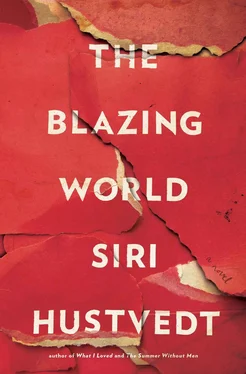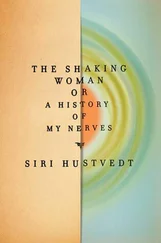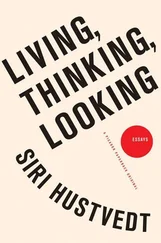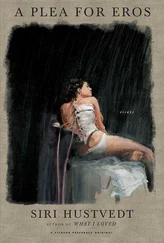4. Large snowflakes fall slowly onto a wet sidewalk.
I didn’t notice the cracks in the walls until we had been losing ourselves inside the maze for about twenty minutes. They were clues. The closer one came to the exit, the more cracks there were. They were not obvious. The texture of the walls changed by increments. Tiny cracks like spiderwebs or broken blood vessels began to mottle the white walls, becoming denser and denser as one neared the exit. Marcelo didn’t notice these veins at all. They were, as the saying goes, hiding in plain sight.
Finally, there were peepholes drilled into three of the maze’s dead ends. These were my favorites. I love peeping. Maybe we all do. When I peeked into the first one we happened upon, I saw a small TV screen deep inside the wall, maybe fifteen inches away from my eyeball. Two tiny figures wearing black masks over their faces, identical caps that concealed their heads, loose dark tunics, and pants stood face to face in a blank room. After a couple of seconds, the two began to waltz, step-two-three, step-two-three, and then they fell into the lilting turns of the dance. It was pleasing and I danced along a little, to Marcelo’s embarrassment, but then the rhythm sped up and went wrong. Like a pair of automatons, the couple’s motion became rigid and mechanical but also out of whack with each other. They danced faster and faster, circling madly and stumbling into each other, until I felt dizzy just watching them, and then the figure I took to be the woman — I think because the other person had rested his hand on her back — tripped and fell. With a violent tug, the man yanked her back to her feet, pulled her body close to him and back into the dance, which began to resemble an upright wrestling match. She twisted and squirmed. She hammered at his arms and tried to release herself from his grasp. They bumped blindly into the wall, but the man held on tightly, and then, without warning, the woman went limp. Her head fell backward, her knees buckled, and her arms fell to her sides. Then the little narrative began again.
This sequence couldn’t have lasted more than a couple of minutes. In the two other peephole films, this sequence was repeated exactly but given another ending. After the woman has collapsed, the man continues his lunatic waltz, but his once-solid human partner has been replaced by a spineless rag doll. The man shakes the doll hard, throws off its mask and cap to reveal an airy nothing, a Ms. Nobody. He lets the bundle fall to the floor, kicks the withered, unoccupied rags in disgust, and walks offscreen. In the third peep show, the one that was just around the corner from the exit, the sequence repeats itself up to this point; but once the man has left the stage, the heap of rags reconfigures by some movie magic into the living dancer, who then spreads her arms and begins to levitate toward the ceiling, slowly rising until only her feet are visible at the top of the screen, and then they, too, disappear. A fairy-tale ending.
Marcelo and I emerged a little dazed from our wanderings. The open space of the gallery beyond the maze came as a relief. I spotted Rune in the noisy crowd, dressed down in jeans, black T-shirt, and a sports jacket, chatting away, a cool customer. I’ve loved that phrase since I was a kid because I’ve always wanted to be one, and I’ve always wondered where the expression came from — a person in a store pretending he doesn’t like the goods, driving the salesperson mad? I told Marcelo that I wanted to scout out the cool customer and so we moved closer to the art star and gossiped about him from our corner. Marcelo thought Rune had a John Wayne — ish feel to him, and I agreed. Wayne’s gunslinger had a touch of swish to him, a bit of the girl in his walk, hips swaying under his holster, with those cute little steps of his. Rune had it, too, that give in his hips. We like our movie stars androgynous, whether we know it or not, both boys and girls.
I looked for Harry, but my dear giantess wasn’t in the room. We spotted an actress from a TV show but couldn’t remember her name, and after a few minutes, Marcelo pronounced the party more bruising than festive, and we made our retreat. From what I could tell it looked like a hit, a big deal, not the little deal our Suffocation Rooms had been, although I have to say I love those heated-up rooms as much as the maze — no, more. When we left the gallery, the line extended all the way down the block. Marcelo and I strolled over to Tenth Avenue to look for a restaurant, and there, standing alone on the corner, in a Burberry trench coat and a green cloche, was Harry. After the three-way multiple-kissing ritual, I told her the maze was great and congrats, et cetera, et cetera, but she didn’t reply. It was dark on the street, but not so dark that I couldn’t see she looked stunned. I gathered that she hadn’t been to the show yet, and I asked her why. She shook her head slowly, her forehead wrinkling. I asked her to join us for a bite, but she refused. After a few more bids to convince her met with no success, Marcelo and I left her.
The parting from Harry tugged at me all evening, and I talked too much about it over my angel hair pasta, which annoyed Marcelo, and we had a spat. Of course, Marcelo had never lived with Harry. She’d never rubbed his back during a Bette Davis movie. He’d never seen her sit and talk quietly to the Barometer about his drawings to calm him down when he needed it or seen her quietly checking on the skinny madman at night to make sure he put Neosporin on his scratches. And Marcelo hadn’t seen Harry twirling around the room in the long violet shantung dress I helped her pick out at Bergdorf’s, singing “Zip-a-Dee-Doo-Dah” at the top of her lungs before her sixtieth-birthday party. I couldn’t blame Marcelo for what he didn’t know.
Richard Brickman (letter to the editor in The Open Eye: An Interdisciplinary Journal of Art and Perception Studies , Fall 2003)

To the Editor,
Ten days ago, I received a sixty-five-page letter delivered to me the old-fashioned way, through the U.S. Post Office. Why Harriet Burden, the author of the letter, entitled “Missive from the Realm of Fictional Being,” chose me as her confessor, I don’t quite know, but she said that she had read my paper published in the pages of this journal and thought my interest in the philosophy of self and the dynamics of perception made me a good recipient for her “revelation.” After verifying that a person named Harriet Burden does, in fact, exist, that she is an artist who a number of years ago exhibited her work in New York City, and that the three artists featured in her letter are also actual persons, I decided to accept her invitation to write my own letter about her letter in these pages. Burden’s “missive” is far too long to be published in full. Its style, at once peculiar and various, includes circumlocutions, elaborate tangents, extravagant quotation, as well as terse philosophical sentences and argumentative leaps which distance it from every standard readers have come to expect from an academic journal. Although I cannot agree with her conclusions, or with her mode of expression (which occasionally veers toward the fervid, exclamatory, and vulgar), I find Burden’s artistic experiment an interesting one, and I believe the readers of The Open Eye will find the material broadly relevant to their concerns.
Although this journal is committed to ongoing conversations among various disciplines, its pages have underscored the difficulties involved in such dialogues because epistemological approaches vary. The burgeoning research on perception in the neurosciences, Anglo-American analytical philosophy, a more unorthodox strain of thought that has emerged out of European phenomenology, as well as poststructuralist theory offer different answers to the question: How do we see?
Читать дальше













